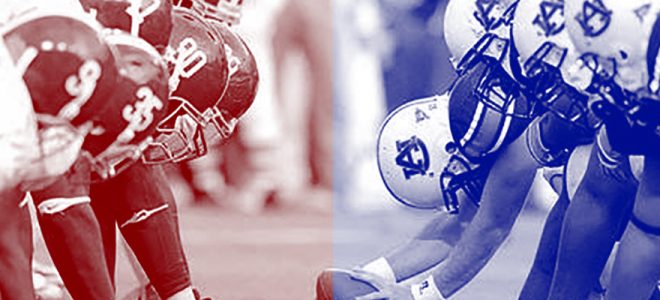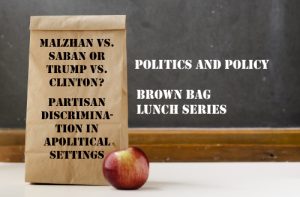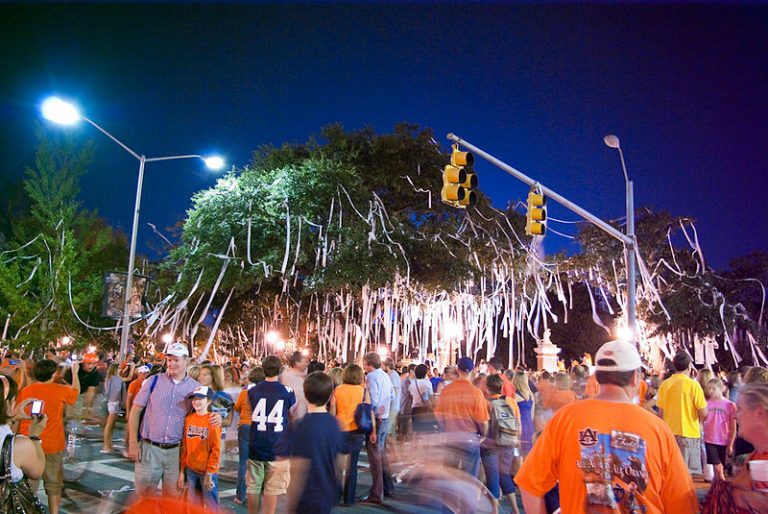

Drew Engelhardt is a political science Ph.D. student at Vanderbilt University. His research focuses on political behavior and public opinion in the United States, centering on the intersection of group politics and social and economic inequality. Substantively he is interested in areas ranging from political party coalitions to race and ethnic politics, with an emphasis on the role race plays in American politics.

Steve Utych is an assistant professor of political science at Boise State University. His research focuses on political psychology, specifically the role of language and emotions in politics.
College football reporter Paul Finebaum dramatically described the heated and longstanding animosity between Alabama and Auburn fans by stating, “It’s really the Israelis and the Palestinians living together in one place, day in, day out.” This correlation between athletic rivalry and politics sums up the partisanship that often creeps into even our most mundane decision making.
Partisanship, defined as our loyalties to one political party over another, has long been viewed as the most consequential of political predispositions, and its importance has increased in recent years. In the 2016 election, party identification proved to be a strong predictor of voter choice – 89 percent of self-identified Democrats voted for Hillary Clinton, while 88 percent of self-identified Republicans voted for Donald Trump. Recently, scholars have shown that partisans hold increasingly negative views of members of opposing parties and feelings of anger toward those parties’ presidential candidates. This has bled into seemingly non-political realms, ranging from negative reactions toward a relative who marries someone who supports a different party to bargaining over cab fare. These partisan biases surpass even racial biases in magnitude. Partisanship is a powerful predictor of political attitudes and behaviors. Given these findings of increased discrimination based on partisan attachments, we wondered if partisan discrimination was still relevant when coupled with other discriminatory factors – such as team affiliation that may be more relevant to the decision task at hand.
SOCIAL IDENTITY THEORY, ATTITUDES AND BEHAVIORS

First, why does partisan discrimination occur? To answer this question, we turn to Social Identity Theory, developed by the social psychologist Henri Tajfel and his colleagues in the 1970s. Social Identity Theory argues social identity, or the groups in society that people feel attached to, can be used to explain differences in attitudes and behaviors between members of different social groups. Individuals can make decisions in an interpersonal manner — where decisions are based on individual characteristics and personal relationships with other people — or in an intergroup manner — where decisions are based on the social categories with which they and the other person identify. In reality, most people tend to make decisions using a mix of both interpersonal and intergroup elements. However, in many instances, individuals do not have much interpersonal information to rely on, so their decisions are heavily based on intergroup considerations. These intergroup considerations are made salient by the specific context; the group attachments that explain decision-making can change based on situational demands. Discussions about religion, thinking about employment, or sitting in a college classroom can make a person’s religious, occupational, or student identities most relevant.
Social Identity Theory predicts two behavioral consequences of intergroup decision making. First, it predicts in-group favoritism. Individuals are more likely to treat those who share social group memberships – such as gender, race, religion, partisanship, and a host of others — more favorably than those with whom they do not share such group memberships. Moreover, in many instances this in-group favoritism produces out-group discrimination, or harsher treatment of individuals with whom we do not share social group membership. For example, in a classic test of social identity theory, individuals were asked to rate famous paintings, and then told that they favored either Klee or Kandinsky paintings (though, this favoritism was assigned randomly and these groups were completely artificial). Those who believed they favored Kandinsky paintings treated others who favored Kandinsky paintings more favorably, and those who favored Klee paintings more harshly, showing that social identity is important even when groups are of minimal importance to individuals.
PARTISANSHIP AND COLLEGE FOOTBALL
In our research, we focused on two types of social attachments — partisanship and college football. As evidenced by watching College Gameday on ESPN, viewing team-branded clothing and bumper stickers, or being on a college campus on a fall Saturday (or, increasingly in Boise State’s case, Friday night), being a college football fan is a relevant and important identity for millions of Americans. This is perhaps most true in one of college football’s most heated rivalries: University of Alabama and Auburn University. This contentious rivalry was best exemplified by Alabama fan Harvey Updyke, who poisoned the Toomer’s Corner trees on Auburn’s campus the week after Alabama’s 2010 Iron Bowl loss to Auburn, and then called radio host Paul Finebaum’s show to brag about it. Alabama fans really do not like Auburn fans, and the feeling is mutual. But does this level of animosity supersede the bitter divisions we see in society between Democrats and Republicans? In other words, when thinking about a context with polarization levels similar to politics, do people ignore partisanship and focus on football loyalties?
To test this hypothesis, we analyzed data collected in October and November of 2016 using Amazon’s Mechanical Turk. Mechanical Turk offers small cash payments to participants who perform simple tasks, such as taking a survey. For this survey, we specifically recruited fans of Alabama or Auburn. First, we collected some basic demographic data about our respondents, and then we presented them with a hypothetical situation regarding the upcoming Iron Bowl game between the two teams. We asked survey participants to imagine that they had two extra tickets to the game that they were trying to sell on craigslist to recover the purchase cost.
In this study, we use experimental methodology. That is, we presented individuals in various groups with different information, and then made comparisons between these groups. Using an experiment to test our predictions presents an array of advantages. First, we are able to control the information presented to our survey respondents – that is, we can vary the partisanship and team attachment of the hypothetical ticket buyer. Further, experiments allow us to make comparisons at the group level, due to the random assignment of individuals to experimental groups. Since assignment is random, we expect that collectively, individuals in each group will be similar on a range of personal characteristics that may influence their decision making; thus, we can attribute any difference between these groups to our experimental manipulation.
Our study comprised four groups. The first group was presented with an email from a man named James Anderson who was interested in buying the tickets at a price slightly lower than the price listed on craigslist. For the second group, the email also contained information about which college James attended. This college was always the college that the respondent did not identify as a fan of (e.g., for all Alabama fans, James was presented as a graduate of Auburn). The third and fourth groups were presented the same information as the second group about James’ team affiliation, but they also were presented with information about James’ political affiliation – he stated that he works for either the state Democratic or state Republican Party. In these final two groups, individuals could make decisions using two different social group considerations – James’ college football team and his partisanship. This scenario was chosen specifically to minimize the likelihood of partisan discrimination – when selling your tickets to a football game, one is quite likely to favor fans of their team. Here, we have chosen a scenario where individuals should be highly likely to discriminate on a basis other than partisanship.
Our analysis compared the results from participants in all four groups. When individuals received team information, they always received out-group information. However, when they received partisan information, they received either in-group or out-group information. That is, Democrats who were told that James works for the Democratic Party received information that James was a political in-group member, while Democrats who were told that James works for the Republican Party received information that he was a member of their political out-group. Social Identity Theory suggests that emphasizing a college football fans’ archrivals should decrease the likelihood of partisan discrimination. People’s decision-making should draw primarily on their college football allegiances and only secondarily, if that, on their party loyalties.
After receiving the experimental manipulation email from James asking to buy the tickets, individuals were then asked if they would sell the ticket to James. Those who were told that James was a co-partisan were about 9 percent more likely to accept James’ initial offer, rather than decline or counter the offer, than those who were told that James was an out-partisan. Co-partisans also were likely to offer a lower minimum price for the tickets, by about $67, than out-partisans. These effects appeared to be driven entirely by in-group favoritism. Those who were told James was a member of their partisan in-group were more likely to sell the ticket, and offer a lower minimum price, than those who were simply told he was a fan of the other team. In contrast, participants who were told he was a member of their partisan out-group were no less likely to sell, and offered a similar price for the tickets, than those who were only told about his team affiliation.
While partisan identity affects behaviors in this apolitical context, we find that it also affects attitudes. We asked participants to rate James on a classic scale of social distance developed by Emory Bogardus. We asked them to rate how happy they would be if James lived in their community, lived next door to them, or married into their family. We found that those in the co-partisan group preferred significantly less social distance from James than those in the out-partisan group, a finding that transcended both in-group favoritism and out-group discrimination.
Participants also showed a greater willingness to trust James when he was a co-partisan, compared to when he was an out-partisan. Individuals in the co-partisan group were more likely than those in the out-partisan group to agree that they would trust James to watch their things during a restroom break during the game, and more of them believed that he would give back the correct change if he went to buy them concessions.
However, partisan discrimination is not all-encompassing. When James did not share a respondent’s partisanship, they were no less likely to view him as a serious or knowledgeable football fan, and they were no more likely to engage in confrontational actions, such as teasing, than individuals with whom James did share partisanship. This suggests that although partisanship may influence some basic behaviors, like price negotiations, it does not lead to a greater desire for conflict above and beyond that caused by team affiliation. It also suggests that partisan discrimination manifests in attitudes like trust and social distance, but not in more inferential attitudes about an individual, like their knowledge or seriousness.

PARTISAN DISCRIMINATION AS A PREDICTOR OF ATTITUDES AND BEHAVIORS
In sum, partisan discrimination can be a powerful predictor of attitudes and behaviors, even in a non-partisan setting. Because we always made James a fan of the rival team, participants in our survey received a powerful and relevant signal on which to discriminate against a hypothetical ticket buyer. From this perspective, the fact that people still engaged in some level of partisan discrimination is all the more interesting and consequential. This discrimination was driven heavily by in-group favoritism, leading individuals to treat members of their own political party more favorably even if they were fans of the rival team. These effects are similar in magnitude to comparing the control group to the team only group – that is, across our outcome measures, in-group favoritism towards co-partisans is comparable to out-group discrimination against fans of the opposing team. Effects for out-partisan discrimination tend to be a bit lower than team-based effects. The effects were also consistent across types of identity; Alabama fans and Auburn fans engaged in partisan discrimination equally, as did Democrats and Republicans.
Several things can be inferred from this. First, this suggests that discrimination along partisan lines occurs even in obviously non-political venues. From a social identity perspective, a preference for a certain football team shouldn’t determine the relevance of partisanship in decision making, but it does. This suggests that partisan discrimination can operate above and beyond other more obvious and generally accepted forms of discrimination. We know that rival college football fans, such as those from Alabama and Auburn, deeply dislike each other. However, this disdain can be somewhat muted by a shared partisan identity, and perhaps a bit amplified by partisan conflict. Our loyalties to political parties matter in how we view the world, and this view extends beyond the voting booth, Facebook debates, and uncomfortable Thanksgiving dinners, and into parts of our lives that seem to be totally irrelevant to politics.